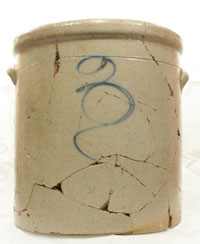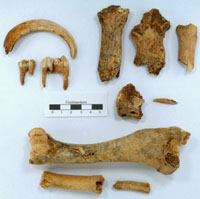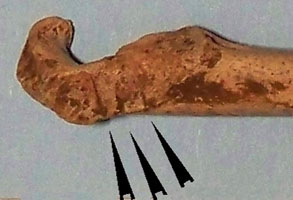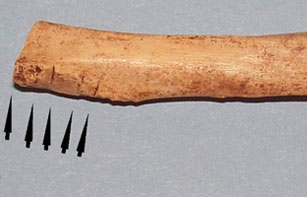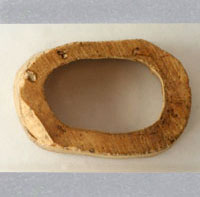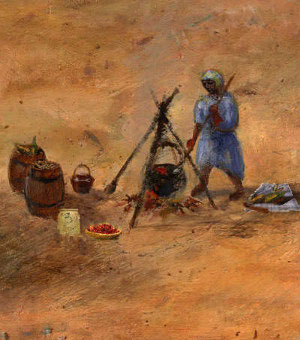
The scent of homemade stew fills the air as Mary Williams cooks over an outdoor fire. Although the cabin had a fireplace, and the family probably did prepare meals inside at times, cooking outdoors was cooler than working over a fire in the small house, and less dangerous as well. Besides, Mary enjoyed watching all the activities going on around her, and she could help keep an eye on her younger brothers and sisters.
Although the general stores in nearby communities carried some canned foods, the Williams family grew or raised most of what they ate. Ransom and his sons also helped supply the family with meat by hunting. As a teenage girl, Mary is taking over some of the responsibilities of preparing meals for the family, not just to help her mother, but also to learn the skills she will need to take care of her own family one day. Keeping long skirts out of the flames was an important skill needed when cooking over an open fire. Infected burns from cooking accidents were still one of the more common causes of injury and death for rural women in the late 1800's.
See what the archeologists found!
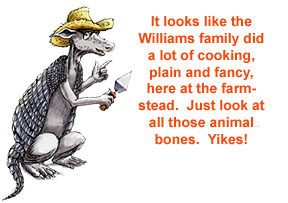
Archeologists learned a lot about what the Williams family ate, how they stored and cooked their food, and how they served it. The team found fragments of the Williams' dishes, utensils, crocks, and pots used for storing food, cooking, and serving meals. They even uncovered the remains of some of the meals at the Williams farmstead, including the bones of pigs, cows, chickens, rabbits, and birds. Some of the bones had distinctive cutting, chopping, and sawing marks made by knives or other metal tools during butchering or before cooking.
Rabbit meat, cut into pieces (2 good-sized rabbits)
Rabbit meat, cut into pieces (2 good-sized rabbits)
3 chopped onions
6 chopped potatoes
A large bunch of greens (wild or home-grown)
6 chopped carrots
Sprigs of herbs
Salt
Lard or other grease
Water
Even though they raised animals for food, Ransom Williams and his sons also added to their family’s food supply by hunting. They probably supplied the family dinner table with rabbit, squirrel, possum, and turkey from the woods on their property, as well as doves and quail. Based on plant remains found at the site, the Williams girls may have gathered wild plants, such as onions, walnuts, and dewberries, and also served corn, sweet potatoes, and peaches from the garden at mealtimes.
Sarah and her girls used heavy cast iron pots for cooking, whether outside over an open fire or inside in the fireplace. The archeologists found dozens of rusted metal fragments that were the remains of pots called Dutch ovens. The pot shown here would have been about 3 inches deep and probably had a lid with an inch deep rim around it to hold coals on top of the dish. This variety had three long metal legs and was often called a spider oven. The legs let the cook place the pot directly into the coals. The thick walls of a Dutch oven make it easier to cook over an open fire without burning the food.
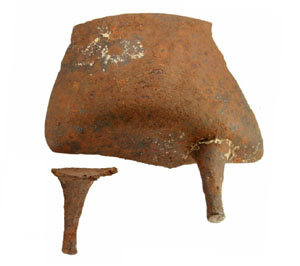
A variety of spoons, forks and knives were found at the Williams’ site. This bone-handled knife was probably considered a fine piece of cutlery. Notice the fancy detail in the metal strips that hold the blade to the bone handle.
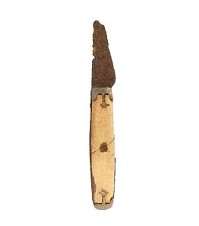
Whether they cooked their meal indoors or outside in the yard, the Williams family could set a pretty fancy table, with dishes imported from England. The blue and white ceramic plate has a mark on the back indicating it was made by the English pottery, Alfred Meakin, between 1875 and 1897. The archeologists glued together dozens of china and glass pieces in order to see what the china patterns looked like and to read the makers' marks on the bottom.
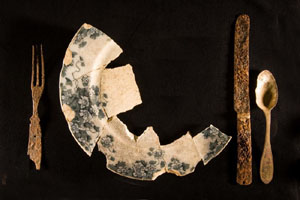
The rusted cans, such as the solder top can and a sardine can found at the site, tell us that the family bought some of their food from the store in town. Before canning methods were developed in the late 1700 and early 1800’s, there were just a few ways, such as drying, salting and smoking, that food could be safely preserved for very long. By the time the Williams family was living on their Texas homestead, many canned foods were available. Farming families sometimes used these foods to get through the winter months when their supplies ran low.
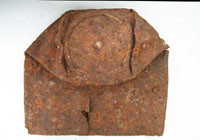
A variety of heavy stoneware crocks and jugs were found at the Williams farmstead. These usually had a lid and were used for storing food to keep it fresh. Other crocks had special wooden paddles inside. These were used to churn cream to make butter.
All in all, it appears that the Williams family had access to a variety of food and they prepared and served it in style.
